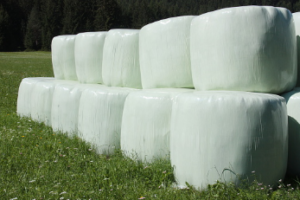silage film: Fodder Preservation Using Silage Film
Fodder preservation with silage film allows farmers to provide livestock with top-grade nutrients throughout winter while saving time and money. Fodder preservation is an invaluable way to maintain a healthy herd while saving precious time and resources.
 Proper application of silage stretch film is critical to achieving optimal results. For optimal results, apply with 50% overlap and the desired stretch amount.
Proper application of silage stretch film is critical to achieving optimal results. For optimal results, apply with 50% overlap and the desired stretch amount.
Airtight Seal
Fodder preservation requires a controlled environment where anaerobic fermentation occurs – this process helps preserve nutrients while minimising spoilage during storage. Fodder preservation silage film technique provides this environment by acting as an airtight seal around forage to prevent oxygen ingress, which would otherwise disrupt anaerobic fermentation and cause spoilage, accompanying loss of nutritional content and spoilage.
Proper sealing methods are key to producing high-quality hay. Unfortunately, however, very limited information exists on optimising these methods. Studies have demonstrated that lining bunker silo walls with plastic film reduces aerobic degradation and produces higher-grade silage.
Opacity in plastic hay wrap also protects silage from sunlight damage, while good overlap between side sheets helps minimise rainwater runoff that could otherwise spoil it. An opaque wrap provides added heat protection in hot weather.
For optimal airtight sealing results, selecting a roll of silage wrap with the appropriate dimensions and quality product is paramount to creating an airtight seal on bales. Make sure it can withstand adverse weather conditions and the rigours associated with baling and wrapping operations – look for one with puncture- and tear resistance for added peace of mind during these processes.
Fermentation
Fermentation involves anaerobic storage and conversion of forages into organic acids, predominantly lactic acid. This conversion prevents spoilage of forage by inhibiting microorganism growth; its quality depends on both anaerobiosis levels and good ensiling techniques, which ensure rapid pH lowering. Air penetration through storage or feed out disrupts anaerobiosis leading to rapid yeast/mould growth as well as heating or DM loss – bunker or bag silos should be protected against oxygen infiltration – silage stretch film will help preserve anaerobiosis by protecting bunker/bag silos from oxygen penetration allowing only anaerobiosis level within.
After being ensiled, green vegetation is compressed into compact bundles known as bales and sealed off using special machinery with multiple layers of silage film to protect from oxygen infiltration and ensure an optimal fermentation process, protecting fodder from pests or adverse weather conditions.
Durability
Silage plastic film protects hay bales and other types of forage from mould, moisture and pests, keeping freshness at its highest for longer. Crafted with strong yet durable materials for maximum strength and efficiency, biodegradable Silage Plastic Film provides farmers with an eco-friendly option to protect their forage products from contamination.
Durability aside, plastic film insulation provides reliable protection from farm equipment and other sources of damage. As it boasts thicker and stronger molecular weight distribution than LDPE film, plastic film insulation is more ductile and resistant to tears with great tear strength than its counterpart. Furthermore, there are no long-chain branching and impurities limiting durability further.
When selecting a silage wrap, it is crucial that it is both strong and puncture-resistant, with a high air permeability rating and has undergone third-party testing to ensure its quality and durability. Look for films that have passed these rigorous tests with flying colours!
With all its advantages, storing bales safely in an appropriate environment and monitoring for signs of decay is vital in maintaining their nutritional value and guaranteeing your animals have enough to eat during winter.
Stretchability
Silage film must stretch well around a bale to create an airtight seal and prevent forage from escaping during transport or storage, protecting from moisture damage, keeping its nutritional value intact, and improving livestock health.
Stretch film for silage can last for up to 12 months outdoors, protecting fodder from environmental damage until it is required. It saves both time and money while protecting its quality.


